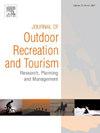‘Into the darkness’ – The caving community and their tourist experiences. The Polish case
IF 3.6
3区 管理学
Q1 HOSPITALITY, LEISURE, SPORT & TOURISM
Journal of Outdoor Recreation and Tourism-Research Planning and Management
Pub Date : 2024-10-09
DOI:10.1016/j.jort.2024.100828
引用次数: 0
Abstract
Descent into the underground requires from explorers not only a high level of physical endurance, technical skills, and ability to use specialized equipment, but also psychological adaptation to severe cave conditions: the darkness, the coldness, and the unknown. The paper focuses on mental states and emotions that accompany cave descents at every stage of the tourist experience. The study examines cavers' tourist motivations as well as perceived benefits of this kind of physical activity. The research aims at the Polish caving community. The study indicates that participation in cave exploration for respondents undertaking cave challenges outside of regular tourism is generally the result of a combination of equally strong factors, rather than a single dominant motivation. The benefits of cave exploration are inwardly directed, those related to creating one’s external image were of marginal importance among survey respondents. A state of ‘focus and concentration’ accompanies cavers during almost the entire stay in cave what not lessen a sense of overall satisfaction, joy, and excitation. To some extent, anxiety, anger, and rarely fear, shape the cave tourist experience.
Management implications
The tourism product of any kinds of tourism should meet the expectations and needs of their participants. Dedicated speleotourists visiting sites outside mass tourism in popular show caves are leading by the complex of motivations typical for tourism as such. However, in the study analysed, the search for beauty and aesthetic impressions next to experiencing the unknown and novelty are explicitly significant motivators for cave exploration, even more important than looking for sport challenges and physical effort. This observation underlines cognitive and emotional meaning, not only sport character of cave exploration.
The research might suggest the general direction in preparation of the offer for dedicated cave tourists: they do not require the creation of new infrastructure (e.g. in terms of cave accessibility) or provision of new amenities, but possibilities of the improvement of technical skills, while enjoying the beauty of the caves, with maintaining a balance between commercialization and the sense of uniqueness and exclusivity of the product.
As pristine and unexplored caves constitute a ‘non-renewable resource,’ thus there is a need for redefinition of ‘the unknown’ and ‘the new’ concepts in cave tourism practiced by dedicated cave tourists (far beyond the geographical sense). The result of this procedure might help meet the expectations of dedicated cave tourists toward their tourist experiences and the attractiveness of sites.
The explorations of dedicated cave tourists occur outside or on the fringes of tourism. To include them in the mainstream of broader tourism, it is necessary to find a balance between commercialization and the uniqueness and exclusivity of the product. The latter should provide satisfaction both in the area of physical well-being and the emotional sphere (sense of community, strengthening bonds).
The study revealed the literature gap in terms of existential authenticity and the recognition of aesthetic and bodily experiences in cave tourism outside of popular show caves.
进入黑暗"--洞穴社区及其游客体验。波兰案例
进入地下洞穴不仅需要探险者具备高水平的身体耐力、技术技能和使用专业设备的能力,还需要他们在心理上适应严酷的洞穴条件:黑暗、寒冷和未知。本文重点关注游客在下洞体验的各个阶段的心理状态和情绪。研究还探讨了洞穴探险者的旅游动机以及对这种体育活动益处的认识。研究对象是波兰洞穴探险界。研究表明,在常规旅游之外进行洞穴挑战的受访者参与洞穴探险通常是多种因素共同作用的结果,而不是单一的主导动机。洞穴探险的益处是由内而外的,与塑造个人外部形象有关的益处在调查对象中的重要性微乎其微。洞穴探险者在洞穴中几乎全程都处于 "专注和集中 "的状态,但这并不影响他们的整体满足感、喜悦感和兴奋感。在某种程度上,焦虑、愤怒以及极少数的恐惧会影响洞穴游客的体验。 管理意义任何类型的旅游产品都应满足参与者的期望和需求。专门的岩洞旅游者在大众旅游之外的热门表演岩洞中游览时,会受到旅游业典型的复杂动机的引导。然而,在所分析的研究中,寻求美感和审美印象,以及体验未知和新奇,显然是洞穴探险的重要动机,甚至比寻求运动挑战和体力消耗更为重要。这一观察结果强调了洞穴探险的认知和情感意义,而不仅仅是运动特征。这项研究或许可以为专门的洞穴游客提供一个总体方向:他们不需要建立新的基础设施(例如,在洞穴的可进入性方面),也不需要建立新的洞穴探险设施。由于原始和未开发的洞穴是 "不可再生资源",因此有必要重新定义专门洞穴游客所从事的洞穴旅游中的 "未知 "和 "新 "概念(远远超出地理意义)。这一程序的结果可能有助于满足专门的洞穴游客对其旅游体验和景点吸引力的期望。要将他们纳入更广泛的旅游业主流,就必须在商业化与产品的独特性和排他性之间找到平衡。后者应在身体健康和情感领域(社区感、加强联系)提供满足感。该研究揭示了存在的真实性方面的文献空白,以及在流行的表演洞穴之外的洞穴旅游中对审美和身体体验的认可。
本文章由计算机程序翻译,如有差异,请以英文原文为准。
求助全文
约1分钟内获得全文
求助全文
来源期刊

Journal of Outdoor Recreation and Tourism-Research Planning and Management
HOSPITALITY, LEISURE, SPORT & TOURISM-
CiteScore
6.70
自引率
5.30%
发文量
84
期刊介绍:
Journal of Outdoor Recreation and Tourism offers a dedicated outlet for research relevant to social sciences and natural resources. The journal publishes peer reviewed original research on all aspects of outdoor recreation planning and management, covering the entire spectrum of settings from wilderness to urban outdoor recreation opportunities. It also focuses on new products and findings in nature based tourism and park management. JORT is an interdisciplinary and transdisciplinary journal, articles may focus on any aspect of theory, method, or concept of outdoor recreation research, planning or management, and interdisciplinary work is especially welcome, and may be of a theoretical and/or a case study nature. Depending on the topic of investigation, articles may be positioned within one academic discipline, or draw from several disciplines in an integrative manner, with overarching relevance to social sciences and natural resources. JORT is international in scope and attracts scholars from all reaches of the world to facilitate the exchange of ideas. As such, the journal enhances understanding of scientific knowledge, empirical results, and practitioners'' needs. Therefore in JORT each article is accompanied by an executive summary, written by the editors or authors, highlighting the planning and management relevant aspects of the article.
 求助内容:
求助内容: 应助结果提醒方式:
应助结果提醒方式:


